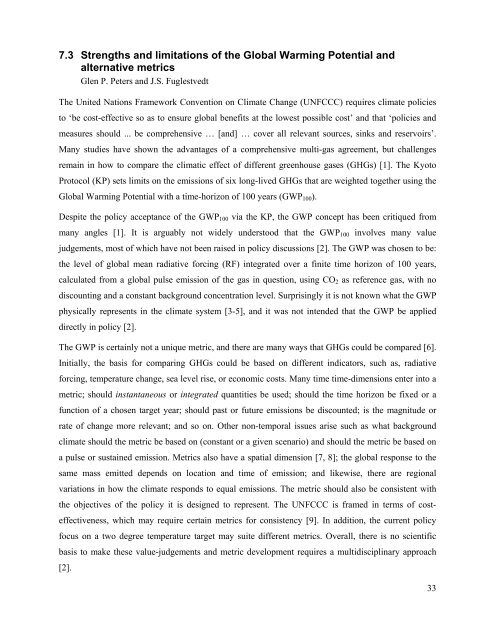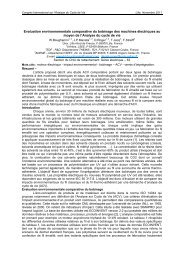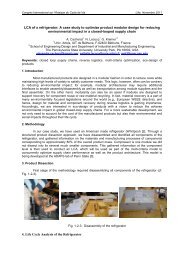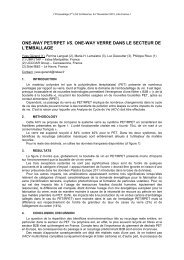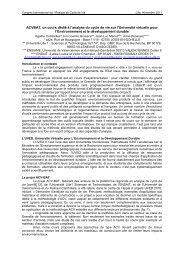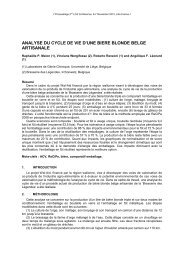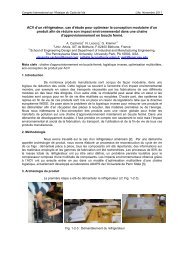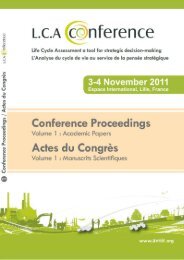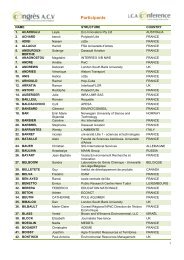Assessing Temporary Carbon Storage in Life Cycle Assessment and ...
Assessing Temporary Carbon Storage in Life Cycle Assessment and ...
Assessing Temporary Carbon Storage in Life Cycle Assessment and ...
You also want an ePaper? Increase the reach of your titles
YUMPU automatically turns print PDFs into web optimized ePapers that Google loves.
7.3 Strengths <strong>and</strong> limitations of the Global Warm<strong>in</strong>g Potential <strong>and</strong><br />
alternative metrics<br />
Glen P. Peters <strong>and</strong> J.S. Fuglestvedt<br />
The United Nations Framework Convention on Climate Change (UNFCCC) requires climate policies<br />
to ‘be cost-effective so as to ensure global benefits at the lowest possible cost’ <strong>and</strong> that ‘policies <strong>and</strong><br />
measures should ... be comprehensive … [<strong>and</strong>] … cover all relevant sources, s<strong>in</strong>ks <strong>and</strong> reservoirs’.<br />
Many studies have shown the advantages of a comprehensive multi-gas agreement, but challenges<br />
rema<strong>in</strong> <strong>in</strong> how to compare the climatic effect of different greenhouse gases (GHGs) [1]. The Kyoto<br />
Protocol (KP) sets limits on the emissions of six long-lived GHGs that are weighted together us<strong>in</strong>g the<br />
Global Warm<strong>in</strong>g Potential with a time-horizon of 100 years (GWP 100 ).<br />
Despite the policy acceptance of the GWP 100 via the KP, the GWP concept has been critiqued from<br />
many angles [1]. It is arguably not widely understood that the GWP 100 <strong>in</strong>volves many value<br />
judgements, most of which have not been raised <strong>in</strong> policy discussions [2]. The GWP was chosen to be:<br />
the level of global mean radiative forc<strong>in</strong>g (RF) <strong>in</strong>tegrated over a f<strong>in</strong>ite time horizon of 100 years,<br />
calculated from a global pulse emission of the gas <strong>in</strong> question, us<strong>in</strong>g CO 2 as reference gas, with no<br />
discount<strong>in</strong>g <strong>and</strong> a constant background concentration level. Surpris<strong>in</strong>gly it is not known what the GWP<br />
physically represents <strong>in</strong> the climate system [3-5], <strong>and</strong> it was not <strong>in</strong>tended that the GWP be applied<br />
directly <strong>in</strong> policy [2].<br />
The GWP is certa<strong>in</strong>ly not a unique metric, <strong>and</strong> there are many ways that GHGs could be compared [6].<br />
Initially, the basis for compar<strong>in</strong>g GHGs could be based on different <strong>in</strong>dicators, such as, radiative<br />
forc<strong>in</strong>g, temperature change, sea level rise, or economic costs. Many time time-dimensions enter <strong>in</strong>to a<br />
metric; should <strong>in</strong>stantaneous or <strong>in</strong>tegrated quantities be used; should the time horizon be fixed or a<br />
function of a chosen target year; should past or future emissions be discounted; is the magnitude or<br />
rate of change more relevant; <strong>and</strong> so on. Other non-temporal issues arise such as what background<br />
climate should the metric be based on (constant or a given scenario) <strong>and</strong> should the metric be based on<br />
a pulse or susta<strong>in</strong>ed emission. Metrics also have a spatial dimension [7, 8]; the global response to the<br />
same mass emitted depends on location <strong>and</strong> time of emission; <strong>and</strong> likewise, there are regional<br />
variations <strong>in</strong> how the climate responds to equal emissions. The metric should also be consistent with<br />
the objectives of the policy it is designed to represent. The UNFCCC is framed <strong>in</strong> terms of costeffectiveness,<br />
which may require certa<strong>in</strong> metrics for consistency [9]. In addition, the current policy<br />
focus on a two degree temperature target may suite different metrics. Overall, there is no scientific<br />
basis to make these value-judgements <strong>and</strong> metric development requires a multidiscipl<strong>in</strong>ary approach<br />
[2].<br />
33


